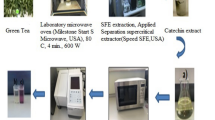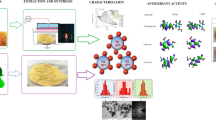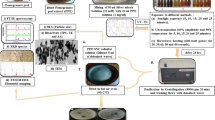Abstract
The synthesis and characterization of Au nanoparticles produced from Punica granatum L. leaves (PGL) grown in Trabzon province of Turkey were investigated in this study. After the pomegranate leaves were collected, they were dried under suitable conditions and divided into small pieces, and Supercritical Fluid Extraction (SFE) was applied to obtain the extract. The SFE was performed at a pressure of 200 bar, 50 °C for a period of 2.5 h using ethanol modifier at 0.5 mL/min flow rate in this procedure. Twenty milliliters of 0.5 mM HAuCl4.3H2O solution was mixed in the microwave device with different volumes of the prepared aqueous solution (0.1 mL and 0.2 mL). After the mixture was exposed to microwaves for 1 to 30 min at a power of 90 W, Au nanoparticles were synthesized. Au nanoparticles produced utilizing green chemistry principles were characterized by UV–Vis, TEM, FTIR, XRD, and Zeta-sizer. The surface plasmon resonance absorption (SPR) spectra were measured using the UV–visible technique to determine the ideal conditions. The TEM images showed that the PGL-AuNPs had a mean size of 23.510 ± 7.009 nm, with sizes ranging from 14.188 to 42.508 nm, and a shape that was triangular, spherical, or elliptical. The reflection peaks appear at 38.21, 44.40, 64.61, and 77.59 corresponding to lattice planes (111), (200), (220), and (311), respectively. The average size of the synthesized gold nanoparticles is 23.24 nm. The Au nanoparticles have an average particle size of 50.76 ± 1101 nm in aqueous medium, a zeta potential of −14.8 ± 0.4 mV, and the polydispersity index for gold nanoparticles is 0.45 ± 0.011, indicating a moderately level of polydispersity. AuNP production was best achieved at 0.5 mM concentration in 0.1 mL pomegranate (P. granatum L.) leaves extract volume. The process utilized for producing the gold nanoparticles allowed for their stability for 2–2.5 months.








Similar content being viewed by others
Data Availability
The information presented in this manuscript is new and has not been published anywhere else. There are figures in this data.
Abbreviations
- AuNPs:
-
Gold nanoparticles
- PG:
-
P. granatum L.
- PGL:
-
P. granatum L. leaves
- PEG-200:
-
Polyethylene glycol-200
- SPR:
-
Surface plasmon resonance
- XRD:
-
X-ray diffraction
- FTIR:
-
Fourier transform infrared spectroscopy
- TEM:
-
Transmission electron microscopy
- ZP:
-
Zeta potential
References
Ge S, Duo L, Wang J, Gegen Z, Yang J, Li TuZ (2021) J Ethnopharma 271:113877
Machado JCB, Ferreira MRA, Soares LAL (2023) Punica granatum leaves as a source of active compounds: a review of biological activities, bioactive compounds, food, and technological application. Food Biosci 51:102220
Sreekumar S, Sithul H, Muraleedharan P, Azeez JM, Sreeharshan S (2014) BioMed Res Int 2014:686921
Kurt H, Şahin G (2013) Marmara coğrafya dergisi 27:551–574
Battineni JK, Boggula NB, V, (2017) Phytochemical screening and evaluation of anti emetic activity of Punica granatum leaves. European Journal of Pharmaceutical and Medical Research 4(4):526–532
Borges RM, Moreira RPM (2016) Estudo etnobotânico de plantas medicinais no municipio de Confresa Mato Grosso. Brasil, Biodiversidade 15(3):68–82
Yl D, Li YL, Zheng TT, Hu MX, Ye TH, Xie YM, Yin WY (2018) The extract from Punica granatum (pomegranate) leaves promotes apoptosis and impairs metastasis in prostate cancer cells. J Sichuan Univ (Eng Sci Ed) 49(1):8–12
Gheith I, El-Mahmoudy A (2017) Potent anti-oxidant and anti-inflammatory potentials of Punica granatum leaf and flower hydromethanolic extracts in vitro. Biosci J 33(2):434–446
Yuniarto A, Sukandar EY, Fidrianny I, Setiawan F, Adnyana IK (2018) Antiobesity, antidiabetic and antioxidant activities of Senna (Senna alexandrina mill.) and pomegranate (Punica granatum L.) leaves extracts and its fractions. Int J Pharm Phytopharmacological Res 8(3):18–24
Haniff Nisha M, Tamileaswari R, SrS J (2015) Analysis of anti-bacterial activity of silver nanoparticles from pomegranate (Punicagranatum) seed and peel extracts. International Journal of Engineering Research & Technology (IJERT) 4(04):1044–1048
Sarkar S, Kotteeswaran V (2018) Green synthesis of silver nanoparticles from aqueous leaf extract of Pomegranate (Punica granatum) and their anticancer activity on human cervical cancer cells to cite this article. Adv Nat Sci: Nanosci Nanotechnol 9:025014
Panghal A, Shaji AO, Nain K, Garg MK, Chhikara N (2021) Bio Comp Health Dis 4(11):260–286
Pieretti S, Saviano A, Mollica A, Stefanucci A, Aloisi AM, Nicoletti M (2022) Phenylpropanoid glycoside from calceolaria spp., displays antinociceptive and anti-inflammatory properties. Molecules 27(7):2183
Stefanucci A, Zengin G, Llorent-Martinez EJ, Dimmito MP, Della Valle A, Pieretti S, Ak G, Sinan KI, Mollica A (2020) Viscum album L. homogenizer-assisted and ultrasound-assisted extracts as potential sources of bioactive compounds. J Food Biochem 44(9):3377
Venthodika A, Chhikara N, Mann S, Garg MK, Sofi SA, Panghal A (2021) Bioactive compounds of Aegle marmelos L., medicinal values and its food applications. Phytother Res 35(4):1887–1907
Chakraborty B, Bhat MP, Basavarajappa DS, Rudrappa M, Nayaka S, Kumar RS, Almansour AI, Peruma K (2023) Biosynthesis and characterization of polysaccharide-capped silver nanoparticles from Acalypha indica L. and evaluation of their biological activities. Environ Res 225:115614
Zahra HM, Ahmad FI, Safad z (2022) Application of nanotechnology in different aspects of the food industry. Discover Food 2:12
Rajeshkumar S, Bharath LV (2017) Mechanism of plant mediated synthesis of silver nanoparticles-a review on biomolecules involved, characterization and antibacterial activity. Chem Biol Interact 273:219–227
Barhoum A, Jeevanandam J, Rastogi A, Samyn P, Boluk Y, Dufresne A, Danquah MK, Bechelany M (2020) Plant celluloses, hemicelluloses, lignins, and volatile oils for the synthesis of nanoparticles and nanostructured materials. Nanoscale 12:22845–22890
Laouini SE, Bouafia A, Soldatov AV, Algarni H, Tedjani ML, Ali GAM, Barhoum A (2021) Green synthesized of Ag/Ag2O nanoparticles using aqueous leaves extracts of Phoenix dactylifera L. and their azo dye photodegradation. Membranes 11:468
Ali GAM, Barhoum A, Gupta VK, Nada AA, El-Maghrabi HH, Kanthasamy R, Shaaban ER, Algarni H, Chong KF (2020) High surface area mesoporous silica for hydrogen sulfide effective removal. Curr Nanoscience 16:226–234
Rastogi A, Singh P, Haraz FA, Barhoum A (2018) Biological synthesis of nanoparticles: an environmentally benign approach. In: Barhoum A, Makhlouf ASH (eds) Fundamentals of nanoparticles. Elsevier, Amsterdam, The Netherlands, pp 571–604
Wibowo A, Tajalla GUN, Marsudi MA, Cooper G, Asri LATW, Liu F, Ardy H, Bartolo PJDS (2021) Green synthesis of silver nanoparticles using extract of cilembu sweet potatoesas (Ipomoea batatas L var. Rancing) potential filler for 3D printed electroactive and anti-ınfection scaffolds. Molecules 26:2042
Said MM, Rehan M, El-Sheikh SM, Zahran MK, Abdel-Aziz MS, Bechelany M, Barhoum A (2021) Multifunctional hydroxyapatite/silver nanoparticles/cotton gauze for antimicrobial and biomedical applications. Nanomaterials 11:429
Chihi S, Bouafia A, Meneceur S, Laouini SE, Ahmed RZ (2023) Effect of precursor concentration on the bandgap energy and particles size for green synthesis of hematite α-Fe2O3 nanoparticles by the aqueous extract of Moltkia ciliata and evaluation of the antibacterial activity. Biomass Conversion and Biorefinery. https://doi.org/10.1007/s13399-023-04739-z
Prabhu NN (2018) Green synthesis of iron oxide nanoparticles (IONPs) and their nanotechnological applications. J Bacteriol Mycol Open Access 6:260–262
Bouafia A, Laouini SE, Khelef A, Tedjani ML (2021) Guemari F (2021) Effect of ferric chloride concentration on the type of magnetite (Fe3O4) nanoparticles biosynthesized by aqueous leaves extract of artemisia and assessment of their antioxidant activities. J Cluster Sci 32:1033–1041
Devi HS, Boda MA, Shah MA et al (2019) Green synthesis of iron oxide nanoparticles using Platanus orientalis leaf extract for antifungal activity. Green Process Synth 8:38–45
Hafeeza M, Shaheena R, Alib S et al (2021) Populus ciliata conjugated of iron oxide nanoparticles and their potential antibacterial activities against human bacterial pathogens. Digest Journal Nanomaterials Biostructures 16:899–906
Naseer A, Ali A, Ali S, Mahmood A, Kusuma H, Nazir A, Yaseen M, Khan M, Ghaffar A, Abbas M (2020) J Mater Res Technol 9(4):9093–9107
Zare M, Namratha K, Alghamdi S, Mohammad YHE, Hezam A, Zare M, Drmosh QA, Byrappa K, Chandrashekar BN, Ramakrishna S, Zhang X (2019) Sci Rep 9(1):8303
Abdullah JAA, Eddine LS, Abderrhmane B, Alonso-Gonzaalez M, Guerrero A, Romero A (2020) Green synthesis and characterization of iron oxide nanoparticles by Pheonix dactylifera leaf extract and evaluation of their antioxidant activity. Sustainable Chemistry and Pharmacy 17:100280
Noruzi M, Zare D, Khoshnevisan K, Davoodi D (2011) Rapid green synthesis of gold nanoparticles using Rosa hybrida petal extract at room temperature. Spectrochim Acta Mol Biomol Spectroscopy 79:1461–1465
Azzi M, Medila I, Toumi I, Laouini SE, Bouafia A, Hasan GG, Mohammed HA, Mokni S, Alsalme A, Barhoum A (2023) Plant extract-mediated synthesis of Ag/Ag2O nanoparticles using Olea europaea leaf extract: assessing antioxidant, antibacterial, and toxicological properties. Biomass Conv Bioref
Nayak S, Goveas LC, Kumar PS, Selvaraj R, Vinayagam R (2022) Plant-mediated gold and silver nanoparticles as detectors of heavy metal contamination. Food Chem Toxicol 167:11327
Yadi M, Mostafavi E, Saleh B, Davaran S, Aliyeva I, Khalilov R, Nikzamir M, Nikzamir N, Akbarzadeh A, Panahi Y, Milani M (2018) Current developments in green synthesis of metallic nanoparticles using plant extracts: a review. Artif Cells Nanomed Biotechnology 46:336–343
Ramesh V, Chenxi S, Pai Z, Thivaharan V, Narasimhan KM, Narayanasamy S, Raja S (2021) Structural characterization of green synthesized magnetic mesoporous Fe3O4NPs@ME. Mater Chem Phys 262:124323
Chan HK, Kwok PCL (2011) Production methods for nanodrug particles using the bottom-up approach. Adv Drug Deliv Rev 63:406–416
Dobrucka R (2017) Synthesis of titanium dioxide nanoparticles using Echinacea purpurea herba Iran. J Pharm Res 16:753–759
Meneceur S, Bouafia A, Laouini SE, Mohammed HA, Daoudi H, Hasan GG, Salmi C (2023) High-efficiency photocatalytic degradation of antibiotics and molecular docking study to treat the omicron variant of COVID-19 infection using biosynthesized ZnO@Fe3O4 nanocomposites. Phys Scr 98:115926
Mondal S, Roy N, Laskar RA, Sk I, Basu S, MandalDand Begum NA (2011) Biogenic synthesis of Ag, Au and bimetallic Au/Ag alloy nanoparticles using aqueous extract of mahogany (Swietenia mahogani JACQ.) leaves. Coll Surfaces B Biointer 82:497–504
Mohammed HA, Souhaila M, Eddine LS, HasanGG KI, Mahboub MS (2023) A novel biosynthesis of MgO/PEG nanocomposite for organic pollutant removal from aqueous solutions under sunlight irradiation Environ. Sci Pollut Res 30:57076–57085
Jeevanandam J, Kiew SF, Boakye-Ansah S, Lau SY, Barhoum A, Danquah MK, Rodrigues J (2022) Green approaches for the synthesis of metal and metal oxide nanoparticles using microbial and plant extracts. Nanoscale 14(7):2534–2571
Nayak S, Sajankila SP, Goveas LC, Rao VC, Mutalik S, Shreya BA (2020) Two fold increase in synthesis of gold nanoparticles assisted by proteins and phenolic compounds in Pongamia seed cake extract: response surface methodology approach. SN Appl Sci 2:1–12
Thiyagarajan K, Bharti VK, Tyagi S, Tyagi PK, Ahuja A, Kumar K, Raj T, Kumar B (2018) Synthesis of non-toxic, biocompatible, and colloidal stable silver nanoparticle using egg-white protein as capping and reducing agents for sustainable antibacterial application. RSC Adv 8:23213–23229
Serdar G, Gül Kılınç G (2023) Microwave assisted production and characterization of gold nanoparticles using green tea and catechin extracts obtained b supercritical extraction method. Chem Pap 77(9):5155–5167
Ahmad MB, Tay MY, Shameli K, Hussein MZ, Lim JJ (2011) Green synthesis and characterization of silver/chitosan/polyethylene glycol nanocomposites without any reducing agent. International Journal of Molecular Science 12:4872–4884
Bastos V, Ferreira de Oliveira JM, Brown D, Jonhston H, Malheiro E, Daniel-da-Silva AL, Duarte IF, Santos C, Oliveira H (2016) The influence of citrate or PEG coating on silver nanoparticle toxicity to a human keratinocyte cell line. Toxicology Letter 249:29–41
Karakoti AS, Das S, Thevuthasan S, Seal S (2011) PEGylated inorganic nanoparticles. Angew Chem 50:1980–1994
Santos MC, Seabra AB, Pelegrino MT, Haddad PS (2016) Synthesis, characterization and cytotoxicity of glutathione- and PEG-glutathione-superparamagnetic iron oxide nanoparticles for nitric oxide delivery. Appl Surf Sci 367:26–35
Sandhanasamy D, AlSalhi MS, Vishnu RB, Jacob ARA, Anis A, Akram AA, Fulwah YA, Fadilah SA, Ahmed HO (2018) Antimicrobial and cytotoxicity effects of synthesized silver nanoparticles from Punica granatum peel extract. Nanoscale Res Letters 13:315
Rahimi H, Doostmohammadi M (2019) Nanoparticle synthesis, applications, and toxicity. In: Stoytcheva M, Zlatev R (eds) Applications of nanobiotechnology. IntechOpen, London, pp 1–17. https://doi.org/10.5772/intechopen.87973
Hammami I, Alabdallah NM, Jomaa AA (2021) Kamoun M (2021) Gold nanoparticles: synthesis properties and applications. J King Saud Uni Sci 33(7):101560
Sökmen M, Demir D, Alomara SY (2018) Optimization of sequential supercritical fluid extraction (SFE) of caffeine and catechins from green tea. J Supercrit Fluids 133:171–176
Uçan HK (2021) Gıda katkısı olarak kullanılan biberiye, kekik ve defnenin etken maddelerinin karşılaştırılmaları üzerine araştırmalar. Afyon Kocatepe Üniversitesi Fen Bilimleri Enstitüsü
Kumar M, Dandapat S, Ranjan R, Kumar A, Sinha MP (2018) Plant mediated synthesis of silver nanoparticles using Punica granatum aqueous leaf extract. Journal of Microbiology & Experiment 6(4):175–178
Rijuta G, Han S, Shin S, Kumar G, Benelli G, Kim DS, Saratale GD (2018) Exploiting antidiabetic activity of silver nanoparticles synthesized using Punica granatum leaves and anticancer potential against human liver cancer cells (HepG2). Artıfıcıal Cells, Nanomedıcıne, And Bıotechnology 46(1):211–222
Aygün A, Özdemir S, Gülcan M, Yalçın MS, Uçar M, Şen F (2022) Characterization and antioxidant-antimicrobial activity of silver nanoparticles synthesized using Punica granatum extract. Int J Environ Sci Technol 19:2781–2788
Joshi SJ, Geetha SJ, Al-Mamari S, Al-Azkawi A (2018) Green synthesis of silver nanoparticles using pomegranate peel extracts and ıts application in photocatalytic degradation of methylene blue. Jundishapur J Nat Pharm Prod 13(3):67846
Elia P, Zach R, Hazan S, Kolusheva S, Porat Z, Zeiri Y (2014) Green synthesis of gold nanoparticles using plant extracts as reducing agents. Int J Nanomed 9:4007–4021
Patel M, Siddiqi NJ, Sharma P, Alhomida AS, Khan HA (2019) Reproductive toxicity of pomegranate peel extract synthesized gold nanoparticles: a multigeneration study in C. elegans. J Nanomater 2019:8767943
Biao L, Tan S, Meng Q, Gao J, Zhang X, Liu Z, Fu Y (2018) Green synthesis, characterization and application of proanthocyanidins-functionalized gold nanoparticles. Nanomaterials 8(1):53
Naeem GH, Muslim RF, Rabeea MA, Owaid MN, Abd-Alghafour NM (2020) Punica granatum L. mesocarp-assisted rapid fabrication of gold nanoparticles and characterization of nano-crystals. Environ Nanotechnol Monit Manag 14:100390
Rao A, Mahajan K, Bankar A, Srikanth R, Kumar AR, Gosavi S, Zinjarde S (2013) Facile synthesis of size-tunable gold nanoparticles by pomegranate (Punica granatum) leaf extract: applications in arsenate sensing. Mater Res Bull 48:1166–1173
Serdar G (2023) Green biosynthesis of silver nanoparticles were obtained from the extract of pomegranate leaves by supercritical extraction using microwave method. Celal Bayar University Journal of Science 19(4):351–358
Goudarzi M, Mir N, Mousavi-Kamazani M, Bagheri S, Salavati-Niasari M (2016) Biosynthesis and characterization of silver nanoparticles prepared from two novel natural precursors by facile thermal decomposition methods. Sci Rep 6(2016):1–13
Sökmen M, Alomar SY, Albay C, Serdar G (2017) Microwave assisted production of silver nanoparticles using green tea extracts. J Alloy Compd 725:190–198
Cherian T, Maity D, Kumar RTR, Balasubramani G, Ragavendran C, Yalla S, Mohanraju R, Peijnenburg WJGM (2022) Green chemistry based gold nanoparticles synthesis using the marine bacterium Lysinibacillus odysseyi PBCW2 and their multitudinous activities. Nanomaterials (Basel) 12(17):2940
Begum SJP, Pratibha S, Rawat JM, Venugopal D, Sahu P, Gowda A, Qureshi KA, Jaremko M (2022) Recent advances in green synthesis, characterization, and applications of bioactive metallic nanoparticles. Pharmaceuticals 15:455
Shakeel A, Annu SI, Salprima Y (2016) Biosynthesis of gold nanoparticles: a green approach. J Photochemi Photobiol B Biol 161:141–153. https://doi.org/10.1016/j.jphotobiol.2016.04.034
Bisht R, Chanyal S, Agrawal PK (2016) Antimicrobial and phytochemical analysis of leaf extract of medicinal fruit plants. Asian J Pharmaceut Clinical Research 9(4):131–136
Liu Z, Zu Y, Fu Y, Meng R, Guo S, Xing Z, Tan S (2010) Hydrothermal synthesis of histidine-functionalized single-crystalline gold nanoparticles and their pH-dependent UV absorption characteristic. Colloid Surf B 76:311–316
Nayak S, Sajankila SP, Rao CV (2018) Green synthesıs of gold nanopartıcles from banana pıth extract and ıts evaluatıon of antıbacterıal actıvıty and catalytıc reductıon of malachıte green dyes. J Microbiol Biotech Food Science 7(6):641–645
Acknowledgements
The author expresses thankfulness to Prof. Dr. Salih TERZİOĞLU, the Central Research Laboratories of Atatürk University, and Karadeniz Technical University.
Author information
Authors and Affiliations
Contributions
GS: analysis, writing, and review and editing.
Corresponding author
Ethics declarations
Ethical Approval
The research study follows publication and research ethics standards.
Competing Interests
The authors declare no competing interests.
Additional information
Publisher's Note
Springer Nature remains neutral with regard to jurisdictional claims in published maps and institutional affiliations.
Rights and permissions
Springer Nature or its licensor (e.g. a society or other partner) holds exclusive rights to this article under a publishing agreement with the author(s) or other rightsholder(s); author self-archiving of the accepted manuscript version of this article is solely governed by the terms of such publishing agreement and applicable law.
About this article
Cite this article
Serdar, G. Biosynthesis and Characterization of Gold Nanoparticles Using Microwave-Assisted Technology from Pomegranate (Punica granatum L.) Leaf Extract Produced by the Method of Supercritical Fluid Extraction (SFE). Plasmonics (2024). https://doi.org/10.1007/s11468-024-02312-6
Received:
Accepted:
Published:
DOI: https://doi.org/10.1007/s11468-024-02312-6




